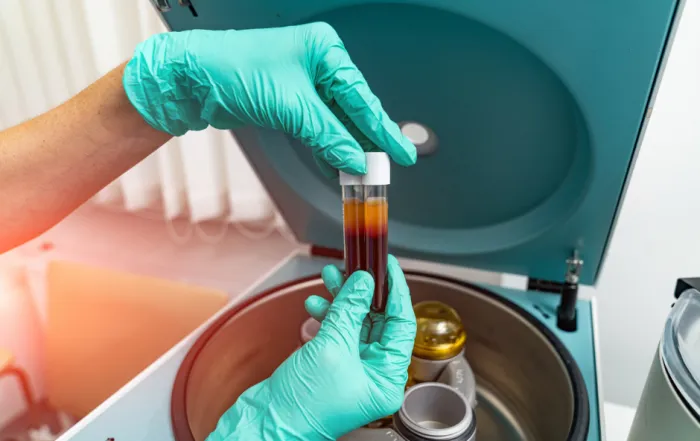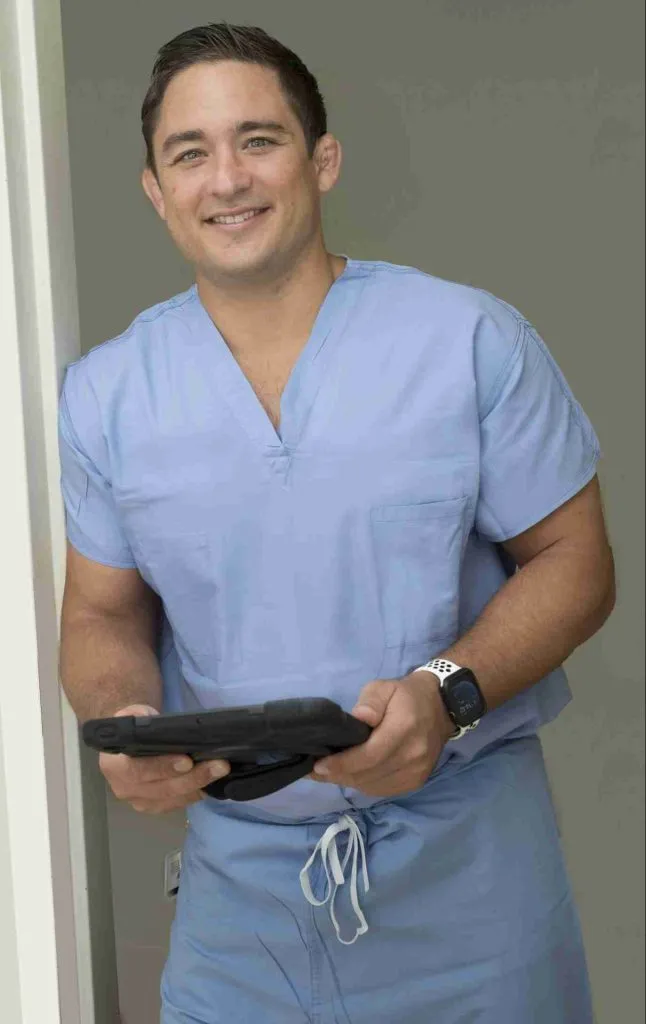
What will I see or feel if my joint is infected?
Signs of knee infection may include fever, fatigue, swelling, redness, localized warmth, drainage of fluid from the knee, or a recurrence of pain or stiffness after full post-operative recovery has been achieved. An x-ray or bone scan can also help your surgeon determine if there is an infection.
If there is visible fluid coming from the surgical site or incision, your surgeon may recommend a culture. A sample of the fluid is collected and tested in a lab to determine what bacteria are present. Blood tests and needle aspiration of fluid surrounding the joint may also be needed to definitively diagnose an infection (Parvizi, et al., 2018).
My Joint is Infected
What are my Treatment Options?
Non-Surgical Treatment
Surgical Treatments
Non-surgical treatment
Surgical Treatments
Debridement, Antibiotics, and Implant Retention (D.A.I.R.)
If it has only been a few weeks since your knee replacement, you may be a candidate for D.A.I.R. This involves surgical debridement (cleaning/washing, removing infected tissue) of the infected knee, followed by 6 weeks of IV antibiotics. You can expect periodic blood tests, needle aspirations, or cultures to determine if the antibiotics are working.
- Only about 50% of patients experience an eradication of infection (Vasso & Panni, 2014).
Single-Staged Revision
- This method involves debridement, removal of the infected prosthesis, and implantation of the new prosthesis in one surgery.
- Benefits
- Fewer surgeries
- Less expensive
- Less risk for potential complications from having multiple surgeries
- Potential for a shorter hospital stay and reduced rehabilitation time
- Lower reinfection rates (4.3% vs. 13.5% in two-stage revisions)
- Outcomes
- 80-90% of patients experience eradication of infection (Kildow, et al. 2020).
- Benefits
Two-Stage Surgical Revision
This treatment option has been used for patients with infections that may have been present for months or years. Eradicating an infection can be difficult if the infection has been present for a long time. It is more common to undergo a two-stage (compared to a one-stage) revision for infection in the United States as it is generally believed to work better.
Stage 1: Stage one involves debridement, removal of the infected knee, and placing an antibiotic-loaded spacer in the joint. The spacer is a device that is implanted in the knee after the infected prosthetic is removed. The spacer allows for joint stability and mobility as well as an infusion of antibiotics into the infected joint (Mazzucchelli, et al. 2015). Stage one also involves 6 weeks or more of IV antibiotics. You will have periodic blood tests to determine if the antibiotics are working.
Stage 2: After it is determined the infection is clear, stage two involves removing the antibiotic spacer, debriding the joint, and implanting a new prosthesis.
- Benefits
- Two chances to debride tissues
- Two chances to assess response to antibiotics during the interval between surgeries
- Outcomes and Risks (Negus, et al., 2017)
- More risk associated with two major surgeries
- Potential for spacer failure leading to further surgeries
- More expensive
- Two separate recovery and rehabilitation periods
- 10% of patients become unfit for the second stage of surgery (Gomez, et al., 2015)
- Increased chance of reinfection 93% (Haddad, et al., 2014)
What’s New in Infection Treatment?
There are many different types of knee spacers to treat infected total knee replacements.
Static Spacers
- For severe bone loss, a static spacer is used. This spacer prevents motion at the knee and acts as a fusion. Many surgeons perform this procedure by placing cement within your knee replacement
- Dr. Morton uses an internal rod to provide stability to your knee during this phase. This provides additional stability, preventing your spacer from dislodging during your recovery.
Mobile Spacers
- Mobile spacers are made of cement that’s bonded to the ends of your femur (thigh bone) and tibia (shin bone). Newer techniques are performed using mobile implants made of metal and polyethylene (plastic) components that are surrounded by antibiotic-impregnated cement. These spacers allow for a more functional knee during your temporary spacer phase. Some patients with these spacers find their knee replacement functional enough that they do need a second surgery to their knee.
Summary
Infection following a knee replacement is uncommon but can be a serious complication. Contact your surgeon immediately if you experience fever, fatigue, swelling, redness, localized warmth on the knee, drainage of fluids from the knee, or a recurrence of pain or stiffness after a full post-operative recovery has been achieved. With appropriate treatment, curing an infection is possible with an expectation of a full recovery and return to normal activities and mobility.
Frequently Asked Questions about Infected Knee Replacements (FAQ)
While the science is conflicting on whether injections are associated with infected knee replacements, many insurance companies have made limitations on joint replacements after injections. If you have an injection, most insurance companies will not support payment for a knee replacement for 3 months after your injection. This is with the health of our patients in mind. Avoidance of infection is of utmost importance as an infection can have devastating consequences.
Most of the spacers will allow you to walk after surgery. The specifics of your case will be discussed with you after your surgery.
Unfortunately, an infected total knee replacement is very difficult to cure. If you have a deep infection, multiple surgeries are often required to cure the infection. You will usually need at least 6 weeks of intravenous antibiotics. Success rates following treatment of an infected knee replacement are variable depending on the chronicity of the infection, type of bacteria, and other medical problems.
Your doctor will obtain certain labs including a Sedimentation Rate (ESR) and C-reactive protein (CRP). Elevated labs demonstrate an inflammatory reaction in your body. They will then take fluid from your knee with a needle. The fluid will be tested for white blood cells and bacteria. Through a combination of these tests, your doctor can help you determine if your knee is infected.
The most common symptom is pain. Some patients have no symptoms but demonstrate a draining wound after surgery. This wound can even appear years later. Other signs include swelling, stiffness, instability, fevers, chills, or low blood pressure.
Related Pages
Faster Recovery: The Subvastus Advantage in Knee Replacements
Total knee replacement (TKR) surgery is a transformative procedure for patients suffering from severe knee arthritis or injury. Among the various surgical techniques, the subvastus approach, Quadriceps Sparing Approach, stands out as a minimally [...]
Knee Replacement Success Rate
Introduction Knee replacement surgery, or knee arthroplasty, is a procedure that has transformed the lives of millions of patients suffering from severe knee pain and mobility issues. Traditionally, the success of such surgeries has [...]
Choosing the Right Specialist for Regenerative Medicine: Ensuring Safety and Efficacy
Regenerative medicine is a rapidly advancing field in healthcare, promising innovative treatments that help regenerate tissues, alleviate pain, and restore function. These treatments require technical knowhow when obtaining platelet rich plasma, bone [...]
Demystifying PRP Therapy: Understanding the Science Behind Platelet-Rich Plasma
In the quest for advanced healing techniques, Platelet-Rich Plasma (PRP) therapy emerges as a beacon of hope for those suffering from various orthopedic conditions, including osteoarthritis and tendon injuries like tennis elbow. This cutting-edge [...]
Moving Forward without Cement: The Pros and Cons of Uncemented Knee Replacements
Introduction Modern medicine continues to break new ground, redefining what's possible. One field where innovation is unceasing is orthopedic surgery, and one of the groundbreaking procedures reshaping the sector is uncemented knee replacements. As [...]
Speedy Recovery: Practical Tips for a Faster Recovery After Knee and Hip Replacement
Introduction Hip and Knee Arthroplasty, more commonly known as hip and knee replacement surgery, is a widely performed procedure that offers a new lease on life for individuals grappling with severe knee conditions, including [...]










